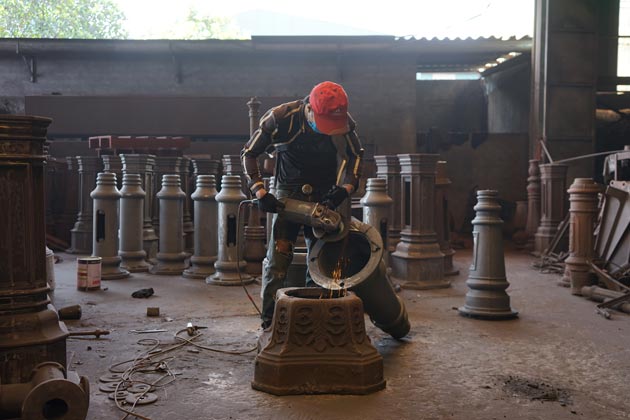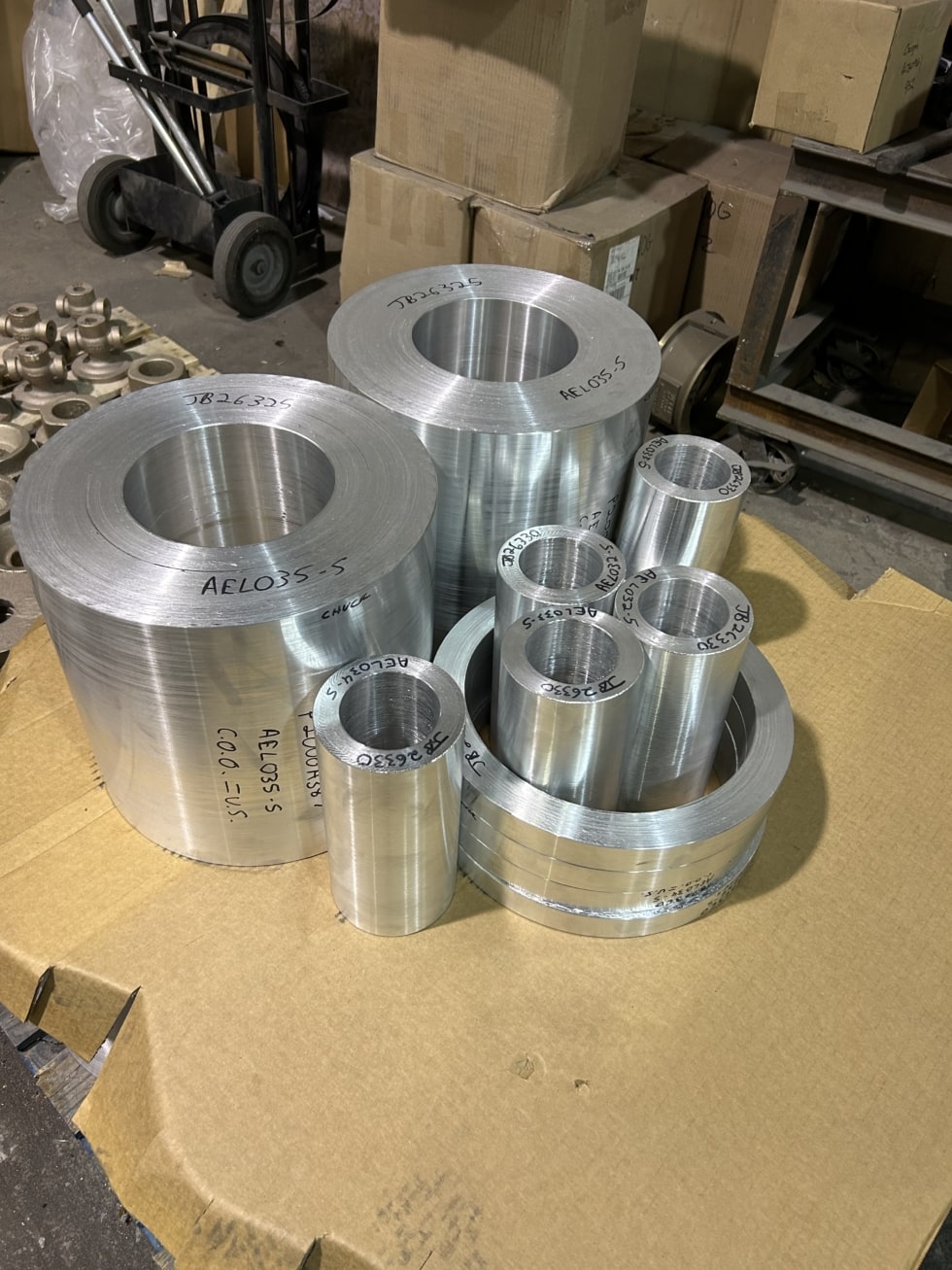Just How Aluminum Foundry Adds To Improvements in Aerospace Engineering
Aluminum shops are essential to improvements in aerospace engineering. They produce lightweight, high-strength parts that are important for contemporary aircraft. With innovative casting techniques, these shops create complex geometries that enhance structural honesty. In addition, the advancement of exceptional Aluminum alloys sustains the industry's emphasis on gas efficiency and sustainability. Challenges remain in the manufacturing procedure. Recognizing these elements reveals the extensive impact of Aluminum on aeronautics's future.
The Relevance of Lightweight Products in Aerospace Style
As the aerospace industry proceeds to evolve, the relevance of lightweight materials ends up being increasingly noticeable. The demand for efficiency and sustainability drives designers to prioritize using products that reduce overall weight without jeopardizing structural integrity. Lightweight materials, specifically Aluminum, play an essential role in enhancing gas performance, improving haul ability, and boosting the overall efficiency of aircraft.
The combination of these products allows for ingenious styles, enabling suppliers to create even more aerodynamic forms that can endure severe conditions. The reduction in weight not just reduces operational prices yet likewise contributes to a reduced environmental impact, aligning with worldwide efforts towards sustainability in air travel.
Advanced Casting Techniques in Aluminum Foundries
Advanced casting methods in Aluminum factories play a crucial duty in aerospace engineering by enabling the production of specific and lightweight elements. Innovations in mold and mildew style and accuracy spreading procedures are important in attaining ideal efficiency and structural honesty. Furthermore, the growth of lightweight alloys improves the total performance and performance of aerospace applications.
Ingenious Mold Style
Innovative mold and mildew design plays a necessary role in the efficiency and performance of Aluminum foundries, specifically within the aerospace field. By leveraging advanced materials and techniques, contemporary molds can be engineered to hold up against high temperatures and stress, guaranteeing peak efficiency during the casting procedure. These styles often integrate intricate geometries that permit for the manufacturing of light-weight yet structurally sound components, vital for aerospace applications. Furthermore, using computer-aided layout (CAD) software application assists in exact modeling, allowing foundries to improve and mimic mold and mildew styles before physical manufacturing starts. This not just enhances the top quality of actors parts however additionally decreases waste and preparation, bring about significant expense financial savings. In general, innovative mold style is a keystone of development in Aluminum Foundry innovation for aerospace engineering.
Accuracy Casting Procedures
The effectiveness of innovative mold designs perfectly incorporates with precision spreading procedures, which are crucial for generating top quality Aluminum components in aerospace engineering. These processes, consisting of sand casting, pass away spreading, and investment spreading, guarantee the development of complex geometries with limited tolerances. Advanced strategies like vacuum casting and pressure die casting enhance the integrity and surface area coating of the end products. Accuracy spreading decreases material waste while making best use of the mechanical residential or commercial properties of Aluminum, critical for aerospace applications. In enhancement, employing real-time tracking and progressed simulation devices throughout the casting procedure allows for immediate changes, bring about enhanced high quality control. Collectively, these precision spreading procedures setting Aluminum shops at the forefront of aerospace advancement, supporting the industry's demand for reliability and efficiency.
Lightweight Alloy Growth
As aerospace engineers seek to improve fuel effectiveness and efficiency, lightweight alloy advancement comes to be a crucial focus in Aluminum foundries. These foundries use sophisticated spreading methods to create alloys that give exceptional strength-to-weight ratios. Innovations in alloy composition, consisting of the incorporation of elements like lithium and magnesium, make it possible for the production of products that hold up against extreme conditions while minimizing total airplane weight. Strategies such as die casting and financial investment spreading assist in the accuracy manufacturing of complex shapes, which are crucial for aerospace applications. Furthermore, recurring research study aims to maximize these alloys for improved mechanical residential properties and raised toughness. By prioritizing light-weight alloy advancement, Aluminum foundries significantly add to the evolution of aerospace engineering, leading the way for much more lasting and effective aircraft styles.

Enhancing Architectural Honesty With Aluminum Components
Aluminum elements use significant advantages in improving structural integrity within aerospace design. Their lightweight nature adds to general efficiency while keeping toughness, which is important for aircraft performance. Additionally, the tension resistance homes of Aluminum help assure the resilience and integrity of aerospace structures under various functional problems.
Lightweight Material Conveniences
While conventional products commonly endanger weight for stamina, using Aluminum components in aerospace design offers substantial advantages in structural integrity. Aluminum's light-weight nature adds to general layout effectiveness, permitting for even more structured aircraft that eat much less gas, therefore improving sustainability. The product's outstanding strength-to-weight proportion guarantees that parts keep resilience without including unnecessary mass. This high quality promotes boosted performance and agility in trip, in addition to optimized payload capabilities. Additionally, Aluminum's resistance to corrosion extends the lifespan of aerospace structures, reducing maintenance costs and enhancing security. As manufacturers progressively embrace Aluminum alloys, the aerospace market experiences a transformative shift in the direction of extra efficient and reliable engineering services that prioritize both efficiency and environmental responsibility.
Stress Resistance Characteristics
Different materials have distinct buildings, Aluminum's remarkable stress resistance stands out as an important aspect in enhancing the structural integrity of aerospace components. This resistance plays a critical function in making certain that airplane can endure numerous functional anxieties, consisting of tiredness, impact, and ecological problems. Aluminum alloys, particularly crafted for aerospace applications, display high tensile stamina while maintaining lightweight characteristics, making it possible for designers to design a lot more efficient frameworks - Aluminum Foundry. Additionally, the capacity of Aluminum to withstand cyclic loading without significant deformation adds to the long life and integrity of aerospace parts. As developments proceed in Aluminum Foundry methods, the development of stress-resistant Aluminum elements guarantees further improvements in performance, safety, and effectiveness across the aerospace market, strengthening Aluminum's function as a recommended material in contemporary engineering
Gas Effectiveness Improvements Driven by Aluminum Innovations
As the aerospace sector looks for to improve gas efficiency, innovative uses resource of Aluminum have actually arised as a crucial service. Aluminum's lightweight nature significantly minimizes airplane weight, permitting reduced gas intake during flight. This decrease in weight is vital, as even little declines can result in significant enhancements in general fuel economy.
Advanced Aluminum alloys, designed for boosted toughness and durability, enable manufacturers to develop components that keep architectural stability while decreasing mass - Aluminum Foundry. Furthermore, the combination of Aluminum in airframes and engine parts assists in boosted aerodynamics, adding to reduced drag and enhanced efficiency
The fostering of Aluminum in aerospace not only satisfies the demand for fuel-efficient design yet also lines up with governing pressures for lower discharges. As these technologies proceed to progress, they play a significant function in establishing new standards for fuel performance, making sure best site that the aerospace sector can satisfy expanding ecological and financial challenges.

The Role of Aluminum in Sustainable Aeronautics Practices
The boosting focus on sustainable air travel practices has placed Aluminum as a crucial product in the pursuit for greener aircraft design. Understood for its light-weight residential or commercial properties, Aluminum significantly reduces aircraft weight, leading to lower fuel usage and emissions. Its recyclability even more boosts its sustainability account, as Aluminum can be recycled forever without loss of high quality. This particular supports a circular economic climate within the aviation sector, minimizing waste and source deficiency.
Additionally, advancements in Aluminum alloys have actually boosted their strength and deterioration resistance, enabling longer solution life and decreased upkeep requirements. These advancements help with the advancement of extra reliable airplane structures, adding to overall sustainability efforts. Furthermore, Aluminum's thermal conductivity plays a vital function in energy-efficient layouts, boosting systems such as warm exchangers. Collectively, these attributes highlight Aluminum's crucial duty ahead of time sustainable aeronautics, straightening with international initiatives intended at minimizing the ecological impact of flight.
Challenges Encountered by Aluminum Foundries in Aerospace Manufacturing
While Aluminum shops play an essential function in aerospace production, they encounter substantial challenges that can influence production efficiency and top quality. One significant challenge is the stringent high quality control standards called for in the aerospace sector. Any problem can compromise safety and efficiency, requiring extensive examination procedures that extend production timelines. Furthermore, foundries typically emulate rising and fall raw product prices, which can affect prices and success. The complexity of Aluminum alloys utilized in aerospace applications further complicates the manufacturing procedure, special info as precise solutions are essential for accomplishing desired mechanical homes. Moreover, knowledgeable labor scarcities impede the capability to preserve top notch production levels. Ultimately, ecological guidelines impose restrictions on emissions and waste management, calling for shops to purchase sustainable techniques, which can be cost-prohibitive. These factors collectively develop a landscape where Aluminum foundries need to continuously adjust to satisfy the progressing demands of aerospace manufacturing while making sure security and conformity.
Future Patterns in Aluminum Applications for Aerospace Design
With improvements in technology and raising demands for efficiency, the future of Aluminum applications in aerospace engineering is positioned for considerable change. The assimilation of ingenious Aluminum alloys and compounds is expected to enhance strength-to-weight proportions, leading to even more fuel-efficient aircraft layouts. In addition, innovations in additive production methods will enable the manufacturing of intricate Aluminum structures that were previously impossible, optimizing efficiency and lowering waste.

Lasting practices will play a crucial duty, with a growing focus on recycling Aluminum to decrease environmental effect. The aerospace sector is most likely to accept smarter making processes, such as automation and man-made knowledge, making sure higher top quality and precision in Aluminum parts. Moreover, partnerships in between Aluminum foundries and aerospace companies will cultivate research and development, paving the way for new applications that fulfill the strict requirements of modern aerospace engineering - Aluminum Foundry. In general, the future looks promising for Aluminum's role fit the skies
Often Asked Concerns
What Are the Environmental Impacts of Aluminum Manufacturing in Aerospace?
The ecological effects of Aluminum production in aerospace include significant energy consumption, greenhouse gas emissions, and environment disturbance. In addition, mining processes can lead to soil destruction and water contamination, increasing concerns concerning sustainability and eco-friendly balance.
Just How Does Aluminum Compare to Various Other Products in Aerospace Applications?
Aluminum uses a special combination of light-weight buildings, deterioration resistance, and cost-effectiveness contrasted to other materials. Its high strength-to-weight ratio makes it particularly advantageous for aerospace applications, improving fuel effectiveness and overall efficiency in aircraft style.
What Qualifications Do Aluminum Foundry Employees Demand for Aerospace Projects?
Aluminum Foundry workers need specialized training in metallurgy and spreading strategies, together with expertise of aerospace industry requirements. Certifications in top quality control and security procedures are likewise important to assure compliance with rigid aerospace project demands.
Exist Any Kind Of Security Worry About Utilizing Aluminum in Aerospace Design?
Safety worries relating to Aluminum in aerospace design include susceptibility to corrosion, exhaustion, and tension fractures. Appropriate treatment and alloy option are necessary to alleviate these risks, making sure architectural integrity and overall safety in aerospace applications.
Exactly How Does Aluminum Recycling Advantage the Aerospace Market?
Aluminum recycling considerably benefits the aerospace industry by reducing product prices, decreasing ecological influence, and preserving energy. This lasting practice improves the industry's effectiveness while advertising making use of lightweight, high-performance components in aircraft production.
Advanced spreading methods in Aluminum factories play an essential duty in aerospace engineering by allowing the production of precise and light-weight components. Cutting-edge mold and mildew style plays a necessary function in the effectiveness and performance of Aluminum foundries, particularly within the aerospace field. As aerospace designers look for to improve fuel performance and efficiency, lightweight alloy growth ends up being a vital focus in Aluminum shops. Aluminum alloys, particularly engineered for aerospace applications, show high tensile stamina while maintaining light-weight qualities, enabling engineers to develop extra reliable frameworks. Partnerships in between Aluminum factories and aerospace firms will certainly promote research study and development, leading the method for new applications that satisfy the strict requirements of modern-day aerospace design.